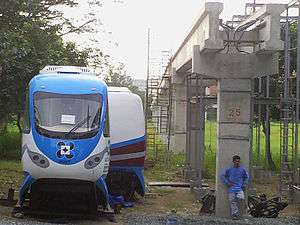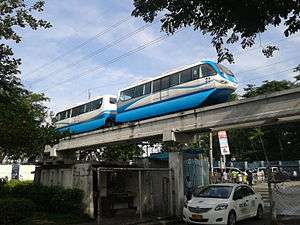Rail transport in the Philippines

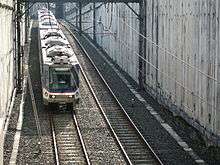
Rail transport in the Philippines is used mostly to transport passengers within Metro Manila. The Philippine railway network consists of one commuter rail service provided by the Philippine National Railways (PNR), and multiple light rail systems operated by the Light Rail Transit Authority and Metro Rail Transit Corporation. Within the last century, there were operating intercity rail lines extending from Manila both north and south, as well as on Panay and Cebu islands. The Philippine Railway Company, which operated both the Panay and Cebu lines, still exists but owns no rolling stock or rail, only property. Other shorter lines were built and operated on Negros island, serving sugar plantations and mills there, as well as elsewhere around the country. Some of those lines still operate seasonally.
History
Luzon

There has been rail transport in the Philippines for over 120 years.[1] On June 25, 1875, King Alfonso XII of Spain promulgated a Royal Decree directing the Office of the Inspector of Public Works of the Philippines to submit a general plan for railroads on Luzon.[2] The plan, which was submitted five months later by Don Eduardo Lopez Navarro, was entitled Memoria Sobre el Plan General de Ferrocarriles en la Isla de Luzón, and was promptly approved. A concession for the construction of a railway line from Manila to Dagupan City was granted to Don Edmundo Sykes of the Ferrocarril de Manila-Dagupan on June 1, 1887.[1] The first rail tracks were laid in 1891 and its first commercial run was in 1892.[1]
At the Tutuban Central Terminal in a bustling district of old Manila was the terminal of the Philippine National Railways for two lines, to the north and to the south. From the center of Manila towards Baguio in the north, the line ended in San Fernando, La Union while the south line stopped in Legazpi City in the Bicol region. To and from these points it carried people and their goods, their trade and livelihood.
Most of the improvements on the rail network were destroyed during Japanese invasion of the Philippines during the World War II. Of the more than a thousand route-kilometers before the war, only 452 were operational after it. For several years after the war, work was undertaken on what could be salvaged of the railroad system.[2]
Panay
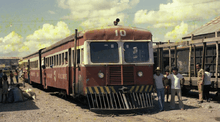
From the beginning of the American colonial period of the Philippines, the new American colonial Insular Government was committed to building new railways. The Philippine Railway Company, predecessor of the current Panay Railways, was incorporated in Connecticut on March 5, 1906.[3] It was part of a "Manila syndicate", a collection of Philippine infrastructure companies including the Manila Electric Railway and Light Company, incorporated in New Jersey, the Manila Construction Company, and the Manila Suburban Railways Company.[4] Later the Philippines Railways Construction Company was added.[4] Cornelius Vanderbilt and William Salomon, among other leading American railwaymen sat on the board.
On May 28, 1906, the Philippine Commission granted to the Philippine Railway Corporation a concession to construct railways on the islands of Panay, Negros and Cebu.[5]
Construction began on a railroad from Iloilo City to Roxas City in Capiz with crews working from both cities and meeting in the middle in 1907.[3] Operations began immediately upon completion.[3] In 1985 passenger operations ceased and in 1989 freight operations ceased.[6]
Cebu
The Philippine Railway Company, along with operating the Panay line, operated a line in Cebu from 1911 to 1942, when operations ceased because of the Japanese occupation of the Philippines during World War II.[7] The line ran from Danao south through Cebu City to Argao.[8] The line was built by the related Philippine Railways Construction Company.[9]
Rehabilitation
Gloria Macapagal-Arroyo's Administration worked to rehabilitate rail transportation in the country, including the Philippine National Railways, through various investments and projects.[1][10] Total reconstruction of rail bridges and tracks, including replacement of the current 35-kilogram (77-pound) track with newer 50-kilogram (110-pound) tracks and the refurbishing of stations, were part of the rehabilitation and expansion process. Much of those plans such as the Northrail Project were controversial and were never completed.
Commuter rail
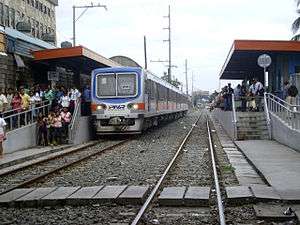
The Philippine National Railways is a state-owned railway system in the Philippines, organized under the Department of Transportation (DOTr) as an attached agency. Established during the Spanish colonial period, the modern PNR was developed only in 1984. It formerly operated around 479 kilometres of track on the island of Luzon, where most Philippine rail infrastructure is located. Because of this, PNR has become synonymous with the Philippine rail system.
A portion of the PNR network, specifically the Metro Manila portion of the network called as the Metro Commuter Line, is part of the Strong Republic Transit System (SRTS),[11] and overall public transport system in the metropolis. It forms the backbone of all of Metro Manila's regional rail services, which extend to its suburbs and to provinces such as Laguna. However, other than reducing growing traffic congestion due to the rising number of motor vehicles in Metro Manila,[12] PNR also aims to link key cities within the Philippines efficiently and to serve as an instrument in national socio-economic development.[13]
However, the meeting of that goal has been beset with problems regarding degraded infrastructure and a lack of government funding,[14] problems that are being rectified with current rehabilitation efforts. The rehabilitation of PNR, which has been touted by various administrations, seeks to not only tackle those problems, but also to spur Philippine economic growth through an efficient railway system. In 2007 the Philippine government initiated a rehabilitation project aiming to remove informal settlers from the PNR right-of-way, revitalize commuter services in Metro Manila, and restore the Manila-Bicol route as well as lost services in Northern Luzon. In July 2009, PNR unveiled a new corporate identity and inaugurated new rolling stock.[15]
Rapid transit
LRTA System



The Manila Light Rail Transit System is the main metropolitan rail system serving the Metro Manila area of the Philippines. There are two lines to the system: LRT-1, called the Yellow Line, and LRT-2, called the Purple Line. Although the system is referred to as a "light rail" system, arguably because the network is mostly elevated, the system is more akin to a rapid transit (metro) system in European-North American terms. The Manila LRTA system is the second metro system in Southeast Asia, built after Bangkok Paknam Railway (discontinued since 1960) by 64 years and earlier than the Singapore MRT by three years. Quick and inexpensive to ride, the system serves 605,000 passengers each day. Every day around 430,000 passengers board the Yellow Line, and 175,000 ride the Purple Line.[16][17]
Its 31 stations along over 31 kilometers (19 mi) of mostly elevated track form two lines. LRT Line 1, also called the Yellow Line, opened in 1984 and travels a north–south route. All of the stations of the LRT-1 and LRT-2 are elevated, except for the Katipunan Stations (which is underground). They follow one of two different layouts. Most Yellow Line stations are composed of only one level, accessible from the street below by stairway, containing the station's concourse and platform areas separated by fare gates.[18]
Many passengers who ride the system also take various forms of road-based public transport, such as buses, to and from a station to reach their intended destination.[19] A reusable plastic magnetic ticketing system has replaced the previous token-based system, and the Flash Pass introduced as a step towards a more integrated transportation system.
The system is not related to the Manila Metro Rail Transit System, or the Blue Line, which forms a completely different but linked system of the Philippine National Railways.
MRTC System
The Manila Metro Rail Transit System has a single line, MRT-3 or the Blue Line. Although it has characteristics of light rail, such as the type of rolling stock used, it is more akin to a rapid transit system. It is not related to the Manila Light Rail Transit System, a separate but linked system.
One of its original purposes was to decongest Epifanio de los Santos Avenue (EDSA), one of Metro Manila's main thoroughfares and home to the MRT-3, and many commuters who ride the system also take road-based public transport, such as buses, to reach the intended destination from a station. The system has been only partially successful in decongesting EDSA, and congestion is further aggravated by the rising number of motor vehicles.[12] The expansion of the system to cover the entire stretch of EDSA is expected to contribute to current attempts to decongest the thoroughfare and to cut travel times. The single line serves 13 stations on 16.95 kilometres (10.5 mi) of line.[20] It is mostly elevated, with some sections at grade or underground. The line commences at North Avenue and ends at Taft Avenue (Taft on the map), serving the cities that EDSA passes through: Quezon City, Mandaluyong, Makati, and Pasay. By 2004 MRT-3 had the highest ridership of the three lines, with 400,000 passengers daily.[21]
AGT System
The automated guideway transit system in UP Diliman will be the first of its kind to be built in the Philippines. Plans for the system were revealed as early as December 2010. The groundbreaking ceremony was held on July 18, 2011. It is still currently under construction and it will be developed within the campus of the University of the Philippines Diliman in Quezon City. It will serve as test track for the first mass transit system to be built and developed in the country by local engineers.[22]
Bicutan AGT
The Bicutan Automated Guideway Transit System is an automated guideway transit (AGT) system under construction and development as of 2011 within the City of Taguig the Philippines. It will serve as test track for the second mass transit system to be built and developed in the country by local engineers.
Davao Monorail
A 28-kilometer monorail project has been endorsed by the City Government of Davao to the Department of Transportation and Communications (DOTC) and Philippine National Railways (PNR).[23]
Baguio-La Trinidad monorail
In December 2013, the Metals, Industry, Research, and Development Center of the DOST and the Baguio City government entered into a memorandum of understanding for the conduct of a study on the possible use of mass transport system in the city, particularly tramline and monorail.[24]
The project feasibility study is now on its final stages and that appropriate validation and evaluation are being undertaken by technical personnel it is finalized and ready for submission to concerned local governments for approval and consideration. He also said that the DOTC will help in sourcing out funds for the eventual realization of the new transport project in the city.[25]
Proposed subway system
MMDA Chairperson Francis Tolentino said that a proposal to build a subway from the Bonifacio Global City in Taguig to an area near a shopping mall in Quezon City. Tolentino also said that the proposal has been complete with geological study showing that a subway is feasible, and that the project is supported by DPWH Secretary Rogelio Singson.[26]
Other Proposals
During the 2016 presidential debates, former Senator Miriam Defensor-Santiago advocated the establishment of an entirely new railway system from Manila to Sorsogon.
President Rodrigo Duterte has expressed his support for the establishment of a train system in the entire island of Mindanao which may be in operation after his term ends. He also expressed support for the restablishment of train systems in Panay, Negros, and Cebu.
Proposals for the reviving of the central and north luzon railway system have come up due to Rodrigo Duterte's train system proposals. Advocates have been gearing for the establishment of a railway that will connect from Manila to Ilocos Norte to Cagayan to Nueva Ecija and back to Manila. Train system advocates in Palawan have also expressed their liking in the establishment of a Palawan train system.
See also
- Department of Transportation and Communications
- Public transport in Manila
- Department of Public Works and Highways
- Strong Republic Transit System (SRTS)
- Transportation in the Philippines
- Charles M. Swift, founder of Meralco and Panay Railways
References
- 1 2 3 4 http://www.pnr.gov.ph/history.htm
- 1 2 http://www.pnr.gov.ph/history_highlights.htm
- 1 2 3 Salvilla, Rex S. (July 28, 2006). "Panay Railways". The News Today.
- 1 2 Swaine, Robert T. (2005). The Cravath firm and its predecessors, 1819-1947. Clark, N.J.: Lawbook Exchange. ISBN 9781584777137.
- ↑ "G.R. No. L-10045 March 25, 1916 (decision of the Supreme Court)". Chan Robles Virtual Law Library. Retrieved 19 May 2014.
- ↑ Angelo, Francis Allan L. (October 30, 2005). "PANAY RAILWAY REHAB NEXT YEAR". The Daily Guardian. Retrieved 12 May 2014.
- ↑ "Ang kasaysayan ng Panay Railways Incorporated". Department of Trade and Communication via the Philippine Railways Blog (an advocacy website). June 5, 2102. Retrieved 12 May 2014. Check date values in:
|date=(help) - ↑ "Cebu Is. PHILIPPINES RAILWAY Co.". Retrieved 17 May 2014. Has map showing roughly the route. In Japanese.
- ↑ Palmera, Erica Jean (15 May 2014). "The old Cebu Railway". The Freeman. Archived from the original on 19 May 2014. Retrieved 25 March 2015.
- ↑ Olchondra, Riza T. (April 22, 2007). "PNR rail rehabilitation to start September". Philippine Daily Inquirer. Manila. Retrieved April 28, 2010.
The Philippine National Railways (PNR) will start repairing and improving its North and South railways by September, PNR General Manager Jose Ma. Sarasola II said Friday.
- ↑ GMA Launches transit system, Philippine Star, July 15, 2003
- 1 2 NUMBER OF MOTOR VEHICLES REGISTERED: Comparative, JAN.- DEC. 2003, 2004, 2005, Land Transportation Office, January 23, 2006
- ↑ Mission Statement, Philippine National Railways, retrieved April 19, 2007
- ↑ The train to Legazpi, Lakbay TV, retrieved August 27, 2006
- ↑ http://www.pnr.gov.ph/
- ↑ http://www.lrta.gov.ph/kpi_line1.htm
- ↑ http://www.lrta.gov.ph/kpi_line2.htm
- ↑ Mga Gabay sa Pasaherong Sasakay ng LRT [Tips for Passengers Riding the LRT]. [ca. 2010] (in Filipino). Light Rail Transit Authority. Retrieved March 13, 2010.
- ↑ http://www.lrta.gov.ph/
- ↑ Route Map, Metro Rail Transit Corporation Passenger Information, retrieved July 7, 2006 Archived June 26, 2006, at the Wayback Machine.
- ↑ MRT-3, UrbanRail.Net. Retrieved July 7, 2006.
- ↑ http://ph.news.yahoo.com/new-up-monorail-coaches-arrive-063028708.html
- ↑ Perez, Ace June Rell S. (October 21, 2015). "Davao City endorses monorail project". Sun Star. Retrieved October 21, 2015.
- ↑ Polonio, Jessa Mardy. "Monorail to ease traffic in Baguio City – study". Rappler.
- ↑ "P1.4 billion to build Baguio-La Trinidad monorail". Manila Standard Today.
- ↑ "Subway in Metro Manila? It can be done - MMDA chief". PHILStar.com. July 18, 2013.
Further reading
- How the Railroad is Modernising Asia, The Advertiser, Adelaide, S. Australia, 22 March 1913. N.B.: The article is of approx. 1,500 words, covering approx. a dozen Asian countries.

